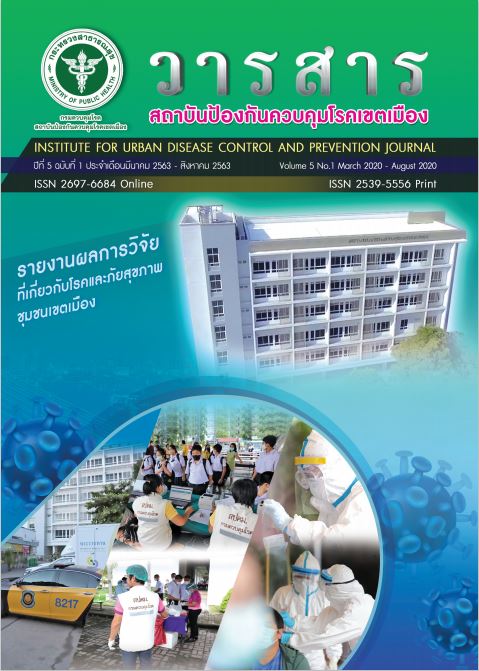การจัดการความเสี่ยงในช่วงแรกของการระบาดโรคติดเชื้อไวรัสโคโรนา 2019 ในเมืองขนาดใหญ่ของประเทศไทย
Main Article Content
บทคัดย่อ
การศึกษานี้มีวัตถุประสงค์เพื่อศึกษากระบวนการจัดการความเสี่ยงช่วงแรกของการระบาดโรคติดเชื้อไวรัสโคโรนา 2019 ในกรุงเทพมหานคร และวิเคราะห์ผลการตอบสนองต่อการจัดการความเสี่ยง ด้านความรวดเร็วในการค้นหา และความรุนแรงของอาการป่วย รูปแบบการศึกษาเป็นภาคตัดขวาง ใช้ระเบียบวิธีวิจัยแบบผสมผสาน กลุ่มตัวอย่างเชิงคุณภาพเป็นเอกสารในกระบวนการจัดการความเสี่ยง ณ สถาบันป้องกันควบคุมโรคเขตเมือง ระหว่างวันที่ 21 มกราคม 2563 ถึงวันที่ 21 มีนาคม 2563 และกลุ่มตัวอย่างเชิงปริมาณเลือกแบบเจาะจง เป็นผู้เข้าเกณฑ์เฝ้าระวัง ณ โรงพยาบาลในกรุงเทพมหานครและได้รับการตรวจการติดเชื้อ SARS-CoV-2 ในช่วงเวลาเดียวกัน จำนวน 4,638 ราย เก็บข้อมูลการจัดการความเสี่ยงตามวงจร Plan-Do-Check-Act วิเคราะห์ข้อมูลเชิงเนื้อหาและคำนวณใช้สถิติเชิงพรรณนา ผลการศึกษาประกอบด้วยการจัดการความเสี่ยง 4 ขั้นตอน ขั้นแรก การวางแผนกิจกรรมให้สอดคล้องกับการประเมินความเสี่ยงที่พบว่าการระบาดอยู่ในระยะที่ 2 มีผู้ป่วยในวงจำกัด และพบจุดแข็ง จุดอ่อน โอกาส และภัยคุกคามการแปลง 6 มาตรการระดับประเทศสู่กิจกรรมในพื้นที่ ขั้นที่สอง การดำเนินงานตามแผน ขั้นที่สาม การวิเคราะห์ผลการจัดการความเสี่ยง พบว่าผู้เข้าเกณฑ์เฝ้าระวังร้อยละ 55.5 ตรวจการติดเชื้อ SARS-CoV-2 ภายในสัปดาห์แรกเมื่อเริ่มมีอาการ ตรวจพบผู้ป่วยยืนยันร้อยละ 8.4 (389/4,638) ผู้ป่วยมีอาการไอมากที่สุด (ร้อยละ 49.9) และขั้นที่สี่การจัดทำข้อเสนอแนะเพื่อปรับปรุงการตอบสนองต่อการระบาดที่มีโอกาสเกิดขึ้นอีก เนื่องจากยังไม่มีวัคซีนที่ป้องกันโรค ดังนั้นการจัดการความเสี่ยงร่วมกับผู้มีส่วนเกี่ยวข้องในพื้นที่ ช่วยให้ผู้เข้าเกณฑ์เฝ้าระวังเข้าถึงการตรวจการติดเชื้อโดยเร็ว ในขณะที่อาการไม่รุนแรง และป้องกันการระบาดในผู้สัมผัสใกล้ชิดผู้ป่วยได้
Article Details
บทความที่พิมพ์ในวารสารสถาบันป้องกันควบคุมโรคเขตเมือง ถือว่าเป็นผลงานวิชาการ งานวิจัยและวิเคราะห์ ตลอดจนเป็นความเห็นส่วนตัวของผู้เขียนเอง ไม่ใช่ความเห็นของสถาบันป้องกันควบคุมโรคเขตเมือง หรือคณะบรรณาธิการแต่ประการใด ผู้เขียนจำต้องรับผิดชอบต่อบทความของตน
เอกสารอ้างอิง
2. World Health Organization. Coronavirus disease 2019 (COVID-19) Situation Report–53 [Internet]. [cited 2020 Mar 18]. Available from: https://www.who.int/docs/default-source/coronaviruse/situation-reports/20200313-sitrep-53-covid-19.pdf?sfvrsn=adb3f72_2
3. World Health Organization. Coronavirus disease 2019 (COVID-19) Situation Report–62 (21 March 2020) [Internet]. 2020 [cited 2020 Apr 18]. Available from: https://www.who.int/docs/default-source/coronaviruse/situation-reports/20200322-sitrep-62-covid-19.pdf?sfvrsn=f7764c46_2
4. Pongpirul WA, Pongpirul K, Ratnarathon AC. Journey of a Thai taxi driver and novel coronavirus. N Eng J Med 2020; 382, 1067-8.
5. Department of Disease Control. Coronavirus disease 2019 situation report-78 (21 March 2020) [Internet]. 2020 [cited 2020 Apr 18]. Available from: https://ddc.moph.go.th/viralpneumonia/file/situation/situation-no78-210363_1.pdf
6. World Health Organization. Health emergency and disaster risk management framework [Internet]. 2019 [cited 2020 Apr 18]. Available from: https://www.who.int/hac/techguidance/preparedness/health-emergency-and-disaster-risk-management-framework-eng.pdf?ua=1
7. Lo S, Chan E, Chan G, Murry V, Abrahams J, Ardalan A, et al. Health emergency and disaster risk management (Health-EDRM): developing the research field within the Sendai Framework Paradigm. Int J Disaster Risk Sci 2017; 8: 145-149.
8. Taylor MJ, McNicholas C, Nicolay C, Darzi A, Bell D, Reed JE. Systematic review of the application of the plan-do-study-act method to improve quality in health care. BMJ Quality and Safety 2014; 23: 290-298.
9. Li Y, Wang H, Jiao J. The application of strong matrix management and PDCA cycle in the management of severe COVID-19 patients. Critical care 2020; 24: 157.
10. Wood LM, Sebar B, Vecchio N. Application of rigor and credibility in qualitative document analysis: lessons learnt from a case study. The Qualitative Report 2020; 25 (2), 456-470.
11. กรมควบคุมโรค (2563). แนวทางเวชปฏิบัติ การวินิจฉัย ดูแล รักษา และป้องกันการติดเชื้อในโรงพยาบาล กรณีโรคติดเชื้อไวรัสโคโรนา 2019. สืบค้นจาก https://ddc.moph.go.th/viralpneumonia/file/g_health_care/g05_010563.pdf
12. World Health Organization (2020a). Novel Coronavirus (2019-nCoV) situation report-1 (21 January 2020). Retrieved from https://www.who.int/docs/default-source/coronaviruse/situation-reports/20200121-sitrep-1-2019-ncov.pdf?sfvrsn=20a99c10_4
13. World Health Organization. Joint External Evaluation of IHR Core Capacities of Kingdom of Thailand [Internet]. 2016 [cited 2020 Apr 18]. Available from: https://apps.who.int/iris/bitstream/handle/10665/272493/WHO-WHE-CPI-REP-2017.38-tha.pdf?sequence=5&isAllowed=y
14. Global Health Security Agenda. GHS Index map [Internet]. 2019 [cited 2020 June 6]. Available from: https://www.ghsindex.org/wp-content/uploads/2019/08/Thailand.pdf
15. Genereux M, Lafontaine M, & Eykelbosh A. From science to policy and practice: a critical assessment of knowledge management before, during, and after environmental public health disasters. Int J Environ Res Public Health 2019; 15: 587.
16. Lee KM, Jung K. Factors influencing the response to infectious diseases: focusing on the case of SARS and MERS in South Korea. Int J of Environ Res Public Health. 2019; 16: 1432.
17. Park PG, Kim CH, Heo Y, Kim TS, Part CW, Kim CH. Out-of-hospital cohort treatment of coronavirus disease 2019 patients with mild symptoms in Korea: an experience from a single community treatment center. J Korean Med Sci 2020; 35 (13): e140.
18. Gostic K, Gomez AC, Mummah RO, Kuchaski A, Lloyd-Smith JO. Estimated effectiveness of symptom and risk screening to prevent the spread of COVID-19. eLife 2020; 9: e55570.


